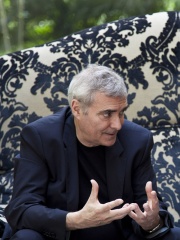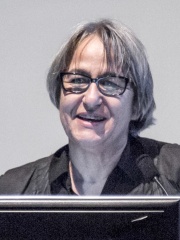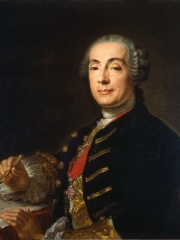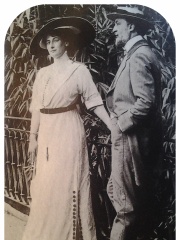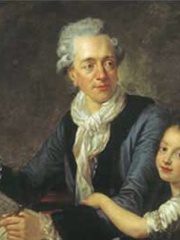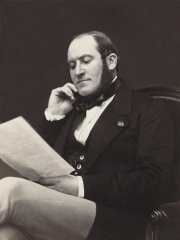
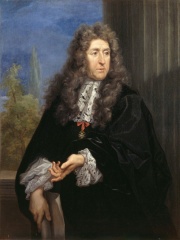
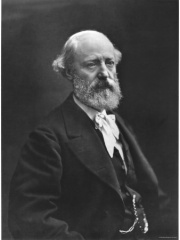
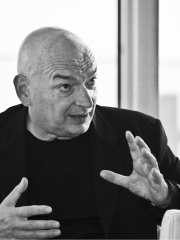
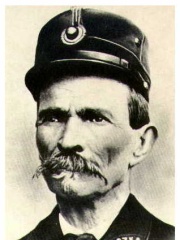
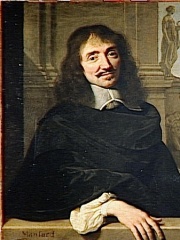
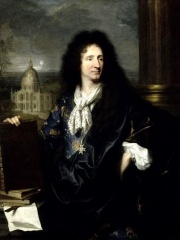
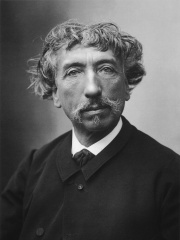
The Most Famous
ARCHITECTS from France
This page contains a list of the greatest French Architects. The pantheon dataset contains 518 Architects, 47 of which were born in France. This makes France the birth place of the 4th most number of Architects behind Germany, and United Kingdom.
Top 10
The following people are considered by Pantheon to be the top 10 most legendary French Architects of all time. This list of famous French Architects is sorted by HPI (Historical Popularity Index), a metric that aggregates information on a biography's online popularity. Visit the rankings page to view the entire list of French Architects.

1. Georges-Eugène Haussmann (1809 - 1891)
With an HPI of 75.89, Georges-Eugène Haussmann is the most famous French Architect. His biography has been translated into 53 different languages on wikipedia.
Georges-Eugène Haussmann (French: [ʒɔʁʒøʒɛn osman]; 27 March 1809 – 11 January 1891), known as Baron Haussmann ([baʁɔ̃ osman]), was a French official who supervised a radical urban renewal programme of new boulevards, parks, and public works in Paris, referred to as Haussmann's renovation of Paris, aimed at introducing grandeur in the city. First a prefect in Var (1849–1850), Yonne (1850–1851), and Gironde (1851–1853), his skills as an administrator led to his appointment in Paris by Emperor Napoleon III in 1853. The signature architectural landmark of his works was the Paris Opera, the largest theatre in the world, designed by Charles Garnier, crowning the centre of Napoleon III's new Paris. Haussmann completely rebuilt Paris above and below ground; on his own estimation by 1870 one in five streets in central Paris were his creation, while revamped sewers now ran alongside miles of pipes to distribute gas for thousands of new streetlights. With his right-hand Adolphe Alphand and at the Emperor's direction, a plan was laid out for four major parks at the cardinal points of the compass around the city: the Bois de Boulogne to the west, Bois de Vincennes to the east, Parc des Buttes Chaumont to the north, and Parc Montsouris to the south. The major parks and their smaller counterparts in the city were an immediate success with all classes of Parisians. Critics forced his dismissal as prefect of Seine in 1870, but his vision of the city still defines much of Paris today. He was made a senator in 1857 and a grand cross of the Legion of Honour in 1862. The Boulevard Haussmann as well as Haussmann–Saint-Lazare station in Paris bear his name.

2. André Le Nôtre (1613 - 1700)
With an HPI of 74.36, André Le Nôtre is the 2nd most famous French Architect. His biography has been translated into 50 different languages.
André Le Nôtre (French pronunciation: [ɑ̃dʁe lə notʁ]; 12 March 1613 – 15 September 1700), originally rendered as André Le Nostre, was a French landscape architect and the principal gardener of King Louis XIV of France. He was the landscape architect who designed the gardens of the Palace of Versailles; his work represents the height of the French formal garden style, or jardin à la française. Prior to working on Versailles, Le Nôtre collaborated with Louis Le Vau and Charles Le Brun on the park at Vaux-le-Vicomte. His other works include the design of gardens and parks at Bicton Park Botanical Gardens, Chantilly, Fontainebleau, Saint-Cloud and Saint-Germain. His contribution to planning was also significant: at the Tuileries in Paris he extended the westward vista, which later became the Avenue des Champs-Élysées within the Axe historique.

3. Eugène Viollet-le-Duc (1814 - 1879)
With an HPI of 73.10, Eugène Viollet-le-Duc is the 3rd most famous French Architect. His biography has been translated into 53 different languages.
Eugène Emmanuel Viollet-le-Duc (French: [øʒɛn vjɔlɛ lə dyk]; 27 January 1814 – 17 September 1879) was a French architect and author, famous for his restoration of the most prominent medieval landmarks in France. His major restoration projects included Notre-Dame de Paris, the Basilica of Saint Denis, Mont Saint-Michel, Sainte-Chapelle, the medieval walls of the city of Carcassonne, and Château de Roquetaillade in the Bordeaux region. His writings on decoration and on the relationship between form and function in architecture had a fundamental influence on a whole new generation of architects, including all the major Art Nouveau artists: Antoni Gaudí, Victor Horta, Hector Guimard, Henry van de Velde, Henri Sauvage and the École de Nancy, Paul Hankar, Otto Wagner, Eugène Grasset, Émile Gallé, and Hendrik Petrus Berlage. He also influenced the first modern architects, Frank Lloyd Wright, Mies van der Rohe, Auguste Perret, Louis Sullivan, and Le Corbusier, who considered Viollet-le-Duc as the father of modern architecture. English architect William Burges claimed that "We all crib from Viollet-le-Duc, although probably not one buyer in ten reads the text". His writings also influenced John Ruskin, William Morris, and the Arts and Crafts movement. At the International Exhibition of 1862 in London, the aesthetic works of Edward Burne-Jones, Christina Rossetti, Philip Webb, William Morris, Simeon Solomon, and Edward Poynter were directly influenced from drawings in Viollet-le-Duc's Dictionary.

4. Jean Nouvel (b. 1945)
With an HPI of 71.37, Jean Nouvel is the 4th most famous French Architect. His biography has been translated into 51 different languages.
Jean Nouvel (French: [ʒɑ̃ nuvɛl]; born 12 August 1945) is a French architect. Nouvel studied at the École des Beaux-Arts in Paris and was a founding member of Mars 1976 and Syndicat de l'Architecture, France’s first labor union for architects. He has obtained a number of prestigious distinctions over the course of his career, including the Aga Khan Award for Architecture (for the Institut du Monde Arabe which Nouvel designed), the Wolf Prize in Arts in 2005 and the Pritzker Prize in 2008. A number of museums and architectural centres have presented retrospectives of his work.
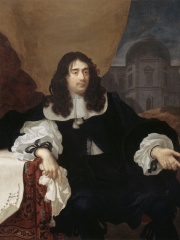
5. Louis Le Vau (1612 - 1670)
With an HPI of 71.19, Louis Le Vau is the 5th most famous French Architect. His biography has been translated into 38 different languages.
Louis Le Vau (French pronunciation: [lwi l(ə) vo]; c. 1612 – 11 October 1670) was a French Baroque architect, who worked for King Louis XIV, the Sun King. Contemporary of both François Mansart and Jacques Lemercier, Louis Le Vau was one of the founders of the French Classical style in the 17th century (Classicisme français), skillfully blending it with Baroque influences. He developed a style marked by the simplicity of structures and the elegance of ornamentation. His masterpiece remains the Vaux-le-Vicomte castle, though he also contributed to the early plans for the Palace of Versailles. His brother, François Le Vau (1613–1676), served as the architect of Saint-Louis-en-l’Île Church in Paris.

6. Ferdinand Cheval (1836 - 1924)
With an HPI of 70.13, Ferdinand Cheval is the 6th most famous French Architect. His biography has been translated into 30 different languages.
Ferdinand Cheval (French pronunciation: [fɛʁdinɑ̃ ʃəval]; 19 April 1836 – 19 August 1924), often nicknamed Facteur Cheval ("Mail Carrier Cheval") was a French mail carrier who spent 33 years building Le Palais idéal (the "Ideal Palace") in Hauterives, in southeastern France. It is regarded as an extraordinary example of naïve art architecture.

7. François Mansart (1598 - 1666)
With an HPI of 69.86, François Mansart is the 7th most famous French Architect. His biography has been translated into 51 different languages.
François Mansart (French pronunciation: [fʁɑ̃swa mɑ̃saʁ]; 23 January 1598 – 23 September 1666) was a French architect credited with introducing classicism into the Baroque architecture of France. The Encyclopædia Britannica identifies him as the most accomplished of 17th-century French architects whose works "are renowned for their high degree of refinement, subtlety, and elegance". Mansart, as he is generally known, popularized the mansard roof, a four-sided, double slope gambrel roof punctuated with windows on the steeper lower slope, which created additional habitable space in the garrets.

8. Jules Hardouin-Mansart (1646 - 1708)
With an HPI of 69.72, Jules Hardouin-Mansart is the 8th most famous French Architect. His biography has been translated into 39 different languages.
Jules Hardouin-Mansart (French pronunciation: [ʒyl aʁdwɛ̃ mɑ̃saʁ]; 16 April 1646 – 11 May 1708) was a French Baroque architect and builder whose major work included the Place des Victoires (1684–1690); Place Vendôme (1690); the domed chapel of Les Invalides (1690), and the Grand Trianon of the Palace of Versailles. His monumental work was designed to glorify the reign of Louis XIV.

9. Charles Garnier (1825 - 1898)
With an HPI of 69.69, Charles Garnier is the 9th most famous French Architect. His biography has been translated into 38 different languages.
Jean-Louis Charles Garnier (pronounced [ʃaʁl ɡaʁnje]; 6 November 1825 – 3 August 1898) was a French architect, perhaps best known as the architect of the Palais Garnier and the Opéra de Monte-Carlo.
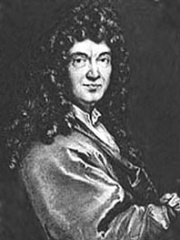
10. Claude Perrault (1613 - 1688)
With an HPI of 69.45, Claude Perrault is the 10th most famous French Architect. His biography has been translated into 33 different languages.
Claude Perrault (French pronunciation: [klod pɛʁo]; 25 September 1613 – 9 October 1688) was a French physician and amateur architect, best known for his participation in the design of the east façade of the Louvre in Paris. He also designed the Paris Observatory and was an anatomist and author who wrote treatises on architecture, physics, and natural history. His brother, Charles Perrault, is remembered as the classic reteller of the old story of Cinderella among other fables.
People
Pantheon has 47 people classified as French architects born between 1290 and 1955. Of these 47, 3 (6.38%) of them are still alive today. The most famous living French architects include Jean Nouvel, Dominique Perrault, and Anne Lacaton. The most famous deceased French architects include Georges-Eugène Haussmann, André Le Nôtre, and Eugène Viollet-le-Duc.
Living French Architects
Go to all RankingsJean Nouvel
1945 - Present
HPI: 71.37
Dominique Perrault
1953 - Present
HPI: 58.70
Anne Lacaton
1955 - Present
HPI: 54.41
Deceased French Architects
Go to all RankingsGeorges-Eugène Haussmann
1809 - 1891
HPI: 75.89
André Le Nôtre
1613 - 1700
HPI: 74.36
Eugène Viollet-le-Duc
1814 - 1879
HPI: 73.10
Louis Le Vau
1612 - 1670
HPI: 71.19
Ferdinand Cheval
1836 - 1924
HPI: 70.13
François Mansart
1598 - 1666
HPI: 69.86
Jules Hardouin-Mansart
1646 - 1708
HPI: 69.72
Charles Garnier
1825 - 1898
HPI: 69.69
Claude Perrault
1613 - 1688
HPI: 69.45
Francesco Bartolomeo Rastrelli
1700 - 1771
HPI: 69.21
Hector Guimard
1867 - 1942
HPI: 68.43
Claude Nicolas Ledoux
1736 - 1806
HPI: 67.43
Overlapping Lives
Which Architects were alive at the same time? This visualization shows the lifespans of the 25 most globally memorable Architects since 1700.

